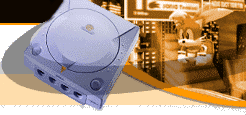| |
Zombie Revenge
The dead can dance (but not very well) - Review By Jetzep
 Helloooo, Sega! Customizing a product prior to taking it from one marketplace to another is a pretty common practice in today's consumer driven world. Helloooo, Sega! Customizing a product prior to taking it from one marketplace to another is a pretty common practice in today's consumer driven world.
After all, you wouldn't expect a Chevy truck to do double duty as a Baywatch rescue vehicle without trick paint, fog lights, a towing kit, wide tires, and a bevy of bimbos, would you?
And the supermarket takes an old fish, cuts it up, pops in some cream cheese and sliced cucumber, wraps it up in rice and seaweed and, voila� sushi.
Well, shame on Sega for failing to recognize that the buying public can sniff out a somewhat uninspired port of an arcade game for what it is when they discover it running on their Dreamcast. They can ...
Zombie Revenge is the latest example of a Naomi arcade game that went nearly untouched into the home market. This is in stark contrast to the likes of Crazy Taxi, whose developers are to be commended for the Crazy Box games, extra level, and other bonuses that they added to their home port.
But I digress. Zombie's story is an offshoot of the original House of the Dead. In it, secret government experiments to turn corpses into soldiers go awry. It's up to the player to select a playable character (two male, one female) to whomp up some "big bad voodoo", daddy. Voodoo comes in the form of fists and weapons - pistols, machine guns, flamethrowers, even industrial drills � you get the picture.
The Good

The interface has a cool, newsreelish feel. |
ZR's front end, the game type and character selection screens fall into the "Wow!" category. I don't care if the game came from Mars, these screens are the Savoy Truffle of eye candy. If the rest of the game were designed and implemented as well, we'd be talking Hall of Fame here (not Hall of Shame, or Hall of Same).
The screens are styled to look like grainy newsreel footage. The digital countdown is graphically paired to a circular second hand sweep (which enhances urgency without becoming annoying). 3D models of the characters stand behind graphical mock-ups of their special agent ID cards. When characters are cycled, their cards shuffle to show appropriate information. The "flick show" graphic style of these screens really helps set the correct mood for horror and adventure. It's too bad the game couldn't have continued this suspension of disbelief.
The character design in ZR is tremendously good, and it looks like the development team paid more attention to surfacing both the characters and the environments than Tiger Woods plays to the 18th green before sinking the winning putt. Both the models and the textures are killer, and the animations are well thought-out and precisely executed. The big bosses make Nemesis (from the ResEvil title of the same name) look like a boy scout, so don't be surprised if you're really shaking in your Wellington boots when you have to face one. The game also has fantastic lighting, flame effects, and real time damage to enemies.
Weapons are generally good fare and all produce an appropriately slushy gush of greenish goo. The best weapons (and, of course, the most sparsely seen) are the flamethrower and the drill. The drill is the kind of thing that Duke Nukem's brother, Deke, would use on the weekend to help assemble a backyard swing set for the Nukem kiddies. It's about twelve feet long. When it enters a zombie, there's a satisfying animation about the zombie and a swirling eddy of greenish slurpie stuff (apologies to 7-11 employees everywhere). Needless to say, that sucker's dead.
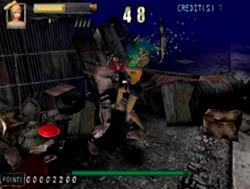
Ouch. That doesn't look comfortable. |
ZR moves right along. Although it starts in fairly pedestrian streets and alleyways, it progresses quickly to rat-infested sewers, industrial plants, and even a moving train. The locales are very dank and dark, but look out; there's almost always one (or more) areas where zombies can drop down and get you into a corner, all the better to pummel you with their meaty little fists.
Sega has also attempted to work in the VMU as something other than a solid-state paperweight, especially since your progress in this game cannot be saved! What they came up with is the Training Room. Think of it as almost like a Zombie Furby. You use the VMU to prepare and equip a character that can then be used in the Dreamcast game's Fighting Mode.
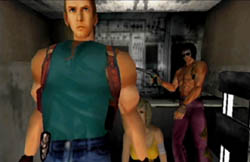
Our heroes. |
Download the Training Room to your VMU from the main game. Beware, it takes up 110 blocks of free memory. A Character Select Screen appears which allows you to select and name the character you're going to rear (don't blame me; it's the term they use in the manual!). By cooperating with the Training Room games, it's possible to increase your character's energy level, reduce stress, and improve offensive and defensive capabilities.
Here's a brief synopsis of the games:
At various times while playing the Original Mode your character can pick up food items. These can be used in combat against Zombies (though a carrot isn't nearly as effective as, say, an Uzi submachine gun). Use the food in the Meal section of the Training Room. Different food items will gradually improve attack and defensive parameters.
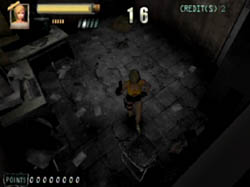
ZR has some really cool graphics, in spots. Resident Evil who? |
Mini Game 1 is called Zombie Fishing. Simple graphics allow you to cast into a pond in the hopes of landing a "big one." The result? Your character's ability to attack will improve if you reel in the big ones. Hey, pass that Bass-a-matic!
Mini Game 2 is called Zombie Doubt. Your character holds up a succession of signs, each containing a symbol (if only they were as cool as the ones in Lucky Charms �). You're supposed to remember what the symbols are, in order, so that you can spot the fake one in a subsequent line-up screen. Failing three successive times means Game Over. This hobby can improve your character's defensive ability.
Are these mini-games worth it? Only the player knows. If you're the sort that really gets into creating and testing new characters within the framework of a traditional game (Monster Rancher and Fighter Maker come to mind) then I'd say, "yes!" If you're like most of the rest of the world and just want to get in and slaughter until you're tired, then I'd say, "no!" Where you fit in is your own business. Of course, if you never bought a VMU or all yours are full, it's a moot point, ain't it?
ZR's manual is fine. It's laid out well, has lots of pictures and diagrams (for rocket scientists like me), and has minimal fine print. But video game manuals can be so funny when they exaggerate their own importance. Do all Dreamcast manuals begin with these words, "Be sure to read this instruction manual thoroughly before you start playing." Yeah � right.
The Bad
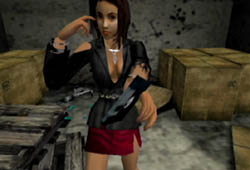
This woman has a minuscule role in the game, yet is still featured on the back of the packaging. Gee, wonder why? |
Graphic slickness and tricked out mini-games aside, this game came directly from a place where the owner wants to hear the sound of the coin drop on the average of once every 1.5 minutes. The game is constructed to go from environment to environment very quickly and with a minimum of fuss (story be damned). At the end of the first segment you save a girl (didn't she look in a mirror before she left the house?) from zombies, and she gives you a � disk. "A man with a golden eye told me to give you this!" she says, all the while attempting to make her blouse dissolve under the stress of her heaving breasts. The disk gives you access to a computerized Max Headroom character who lets you select from three cards. Unfortunately, all of them send you to the same place, which is par for the course in Zombie Revenge.
The home version of ZR is extremely hard to play, for all the wrong reasons. Control is iffy at best. Taking aim and hitting the target (at least the one you wanted to hit, that is) is a major accomplishment. The characters move fluidly enough, but aiming and firing is still constricted to eight directions. Therefore, you can be standing right next to the zombie you want to kill and not hit it if one or the other of you moves slightly. More likely, the zombie will just attack and/or kill you. ZR makes you wish for something that controlled as well as� Sonic Adventure?
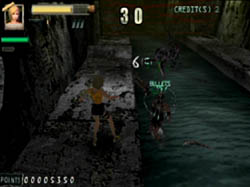
ZR's controls aren't very good. Sometimes shooting a Zombie standing right next to you seems impossible. |
Compounding this flaw is an unacceptable lag in response time, though why this should be is a mystery. After all, gun games have been around almost as long as video games themselves, and punching games even longer. Programming a gunshot or a haymaker shouldn't be rocket science. Unfortunately, it evidently is within some parts of Sega Product Development.
It doesn't take a Sherlock Holmes (or a Fox Muldur) to figure out that in arcades it's more than acceptable to require learning of patterns and actions (just ask anyone who's ever played Dragon's Lair). Arcade owners love it because having to learn a game from start to finish rakes in large amounts of quarters, tokens, card swipes, or whatever coin of the realm is popular at your local arcade. If Sega had tuned the control and timing to an acceptable level for the home market, the game might now be beatable in under 20 minute, just like Dynamite Cop, Sega's other recent Dreamcast disappointment.
As mentioned before, Sega has worked around this by offering different play modes: Arcade (a recreation of the Arcade version of the game); Original (most players should start here); Vs. Boss (head to head with the game's level bosses); Fighting (uses the VMU games mentioned above); and Training Room.

Bleh. You'll either get sick of Zombie Revenge or solve it pretty quickly, so you may want to just rent or borrow this one. |
Because the Arcade and Original are so difficult and repetitive, Sega's Vs. Boss Mode is the one most people (especially ones who are renting the game) should gravitate towards. It eliminates all the chaff and clutter of the lesser zombies and allows you to pit yourself against the biggest and baddest.
I would have loved to have been a fly on the wall during the design meeting where it was agreed upon that some of the power ups dropped by the zombies would be food items. Where is it in the Super Zombie Soldier manual that zombie soldiers would carry around things like tins of tuna, ruby red apples, crunchy carrots, and sprigs of spinach? I know these things are catalogued for later use in a VMU game, but it really hurts suspension of disbelief when you're suddenly picking up a lovely, ripe tomato and stuffing it in your tunic (well � doesn't it?).
Finally, ZR's music is sufficiently creepy, and there's careful attention given to the voices used during cut scenes, etc. Severely lacking, however, is the voice that announces what weapons and other doo-dads you've picked up as you're fighting. Naturally you need
ammunition to keep capping the zombies, but do you really need to hear that voice saying "Boo-litz � Boo-litz � Boo-litz" again and again and again?
The Final Word
Save a few bucks by renting ZR. Enjoy the graphics (which are quite sumptuous) and dabble in the VMU mini-games. However, as you hand the CD back to the clerk, have these words all practiced and ready to speak; repeat after me: "Anybody turn in a copy of Crazy Taxi yet?" You see, Crazy Taxi will drive you to happy distraction; ZR will just
drive you nuts. Satisfaction, it seems, goes to the quick, not the dead.
Developer: Sega
Publisher: Sega
Genre: Action
Highs: Great graphics, slick interface.
Lows: Lame control and responsiveness, horrible repetition, not much longetivity.
Other: 1-2 Players, VMU Compatible (each save requires 5 blocks), Arcade Stick Compatible, VGA Box Compatible, Jump Pack Compatible.
|
Final Score:

(out of a possible 10)
|
Visit this Game's Dreamcast Database Entry
Previous Reviews
Comments on this review? Mail Feedback.
|

